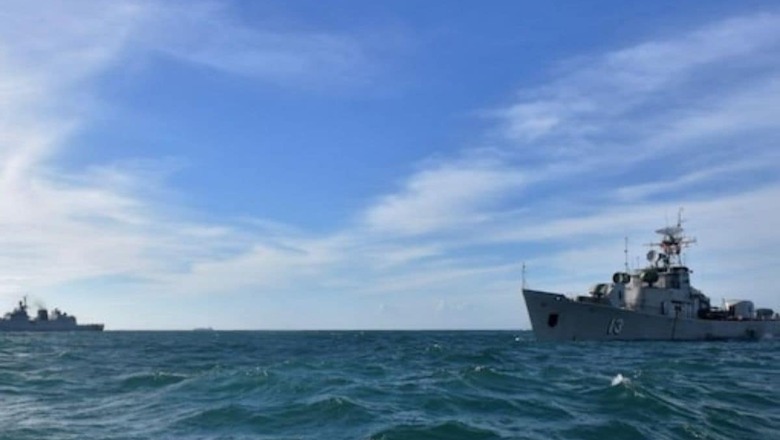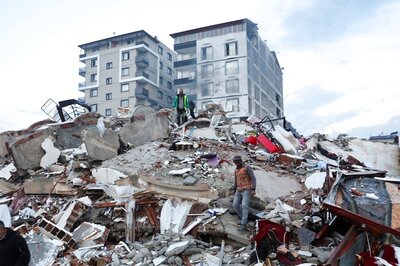
views
Last week marked the 50th anniversary of an Arbitral Tribunal Award of 12 July 2016, rejecting China’s extensive claims in the South China Sea. The Tribunal, constituted under the United Nations Convention of the Law of the Seas (UNCLOS), said that the maritime features in the Spratly Islands group were not “islands” and could not generate Exclusive Economic Zones (EEZ) or continental shelves; they were, at best, high tide features that could generate a territorial sea of 12 nautical miles.
Further, the ruling said that China had no claim to an area that was determined by the Tribunal to be a part of the Philippines EEZ and continental shelf. However, it did not otherwise take a position on the claims of various countries. Importantly, the award rejected Chinese claims to the South China Sea on the basis of historic rights as expressed by its Nine-Dash Line.
China claims most of the South China Sea; a claim contested by five other states—the Philippines, Vietnam, Malaysia, Brunei, and Indonesia—who claim different parts of the sea through which approximately US $5 trillion in shipping passes every year.
In the past decade, China has built artificial islands around some of the high and low tide features, and established military bases there, but under the Award, they make no difference to its maritime entitlement, leading the US to challenge the Chinese claims through so-called “Freedom of Navigation” operations.
The US took the opportunity of the anniversary to reaffirm a Trump administration decision of July 2020, to uphold the Arbitral Tribunal ruling. Prior to that, the US had taken a neutral position between China and the other claimants of the South China Sea. In a statement, US Secretary of State, Anthony Blinken, also affirmed “that an armed attack on the Philippine armed forces, public vessels, or aircraft in the South China Sea would invoke US mutual defense commitments.”
The Philippines was the country that placed the issue before the UNCLOS Tribunal in 2013 because it has had to face steady Chinese encroachment of its EEZ. The Arbitral Tribunal ruling specifically noted that the PRC could not lawfully assert a maritime claim derived from Scarborough Reef and the Spratly Islands with the Philippines since these were found to be in the latter’s EEZ and continental shelf. Further, China had no lawful claim on Mischief Reef or the Second Thomas Shoal, both of which were under the Philippines jurisdiction.
Initially, the Philippines had played down its victory, and sought to deal directly with China on the issue. But speaking to the UN General Assembly in September 2020, President Rodrigo Duterte made it a point to declare that the “the Award is now part of international law, beyond compromise and beyond the reach of passing governments to dilute, diminish, or abandon.” However, the President has more recently, in May 2021, made statements rubbishing the ruling itself.
Four of the five countries in contention with China on South China Sea island claims are from the Association of South East Asian Nations (ASEAN). Yet, the grouping has not openly taken a position on account of countries like Laos and Cambodia who are close to Beijing. The Chinese have resolutely refused to accept external mediation on the issue and have insisted that they would not like to negotiate with the ASEAN but prefer to undertake bilateral negotiations with the countries involved.
The ASEAN has not taken any position on the issue and its members who have disputes with China, too, are cautious in calling out Beijing on the issue. Instead, they use the tactic of using notes verbale to the UN, which specifically mention the UN and the Tribunal award.
In June 2019 the ASEAN had issued its first outlook on the Indo-Pacific which called for “cooperation for peaceful settlement of disputes” as well as the promotion of “maritime safety and security, and freedom of navigation and overflight.” The Chinese have, instead, sought to undertake confidence building measures like the legally non-binding “Declaration on the Conduct of Parties in the South China Sea (DoC of 2002) and, thereafter, sought to work out a legally binding Code of Conduct (CoC), which is aimed at ensuring that the dispute does not get out of hand. But the Chairman’s statement of the 36th and 37th ASEAN summits, held under the chairmanship of Vietnam, have made a call for upholding the international law, and affirming that UNCLOS was the basis for determining maritime entitlements.
The challenge for the ASEAN claimants in the South China Sea is that status quo helps China to consolidate its claims. While verbally, at least, with Vietnam as chairman, the ASEAN has taken a clear-cut position in favour of the implementation of UNCLOS rules, the problem is that this year the chair is being held by Brunei, a tiny sultanate which has kept its head down, even though Chinese claims include its territory. And in 2022, Cambodia, which is close to China, will be the organisation’s chair. As it is, there are concerns over the fact that Phnom Penh has asked the Chinese to expand its naval facility in Ream and there are worries that it could mean giving the PLA Navy (PLAN) an enclave there.
All of this is water off a duck’s back to China which has maintained its policy of not accepting the Arbitral Tribunal Award and refusing to recognise its legitimacy. The Chinese have been actively engaged in its classic tactics of establishing administrative jurisdiction over disputed area and passing domestic laws to enforce it such as the January 2021 Coast Guard Law and the April 2021 Revised Maritime Traffic Safety Law.
At the time the Award was made in 2016, the Chinese trashed the verdict as being “null and void.” It had said that the Chinese claims to the Nanhai Zhudao (South China Sea islands) were based on history, Chinese law, and UNCLOS itself. A Chinese official even raised questions about the biases of the arbitrators. But in a White Paper a day after the award was announced, even while rejecting the verdict, the Chinese called for a settlement of the issue through negotiations. It gave assurances over the freedom of navigation and overflight and it called for peace and stability in the region to be “jointly upheld by China and ASEAN member states.”
China’s 1992 law on the territorial seas and contiguous zones had declared that the Four Sha’s — Dongsha (Pratas), Xisha (Paracel), Zhongsha (Macclesfield Bank and Scarborough Shoal) and the Nangsha (Spratly Islands)—were Chinese territory. Needless to say, as the Arbitral award noted, no feature in the Spratly islands was an island and other features could, at best, generate a 12 nautical mile territorial sea.
With the basis of the Nine-Dash Line undermined by the Arbitral award, the Chinese shifted tack to argue their claims through a mix of several legal principles. At one level, the Chinese claimed the four Sha’s as part of their historical waters, at another as part of China’s 200 nautical mile EEZ and also that they were part of its extended continental shelf. But till now there has been clear cut and coherent legal argument of its case.
In the meantime, the region continues to be a potential conflict zone. Tensions have always been there over the Chinese actions against Filipino fishermen near the Scarborough Shoal. Now, there are signs of growing three-way tensions between China, Vietnam, and Indonesia in the Natuna islands, where the three have overlapping claims. Jakarta, which earlier saw itself more as a mediator than an interlocutor, is now increasingly drawn into the issue.
Recently, it has drawn closer to the US and is working with the US to establish a new maritime training centre with the US near Singapore. Last year the Chinese sought to coerce the Malaysian oil company Petronas’ oil drilling operations amidst a show of force by the US and its allies. Last month, Chinese Coast Guard vessels harassed Malaysian vessels near the Kasawari gas field. More dramatic was the episode on May 30 when 16 Chinese aircraft flew over waters disputed with Malaysia resulting in the Malaysians scrambling their fighter aircraft to check them out.
But, perhaps, the reaffirmation by the US of upholding its defence commitments with the Philippines is the most significant pointer to the future. The most sensitive part of the South China Sea dispute lies in the waters between the Philippines and China. This has a great deal to do with Beijing’s desire to protect its nuclear missile bastion, adjacent to its major Hainan Island nuclear submarine base.
This article was first published on ORF.
Read all the Latest News, Breaking News and Coronavirus News here.


















Comments
0 comment